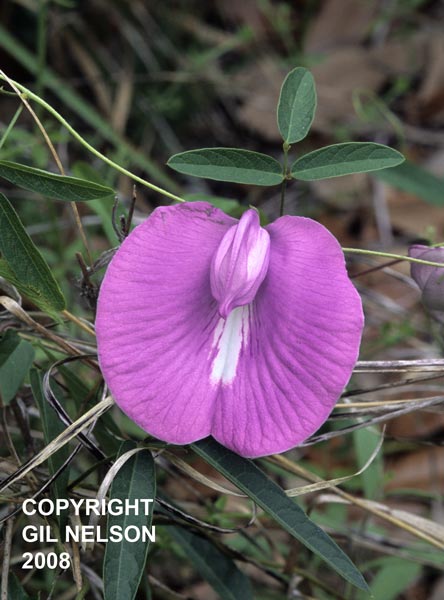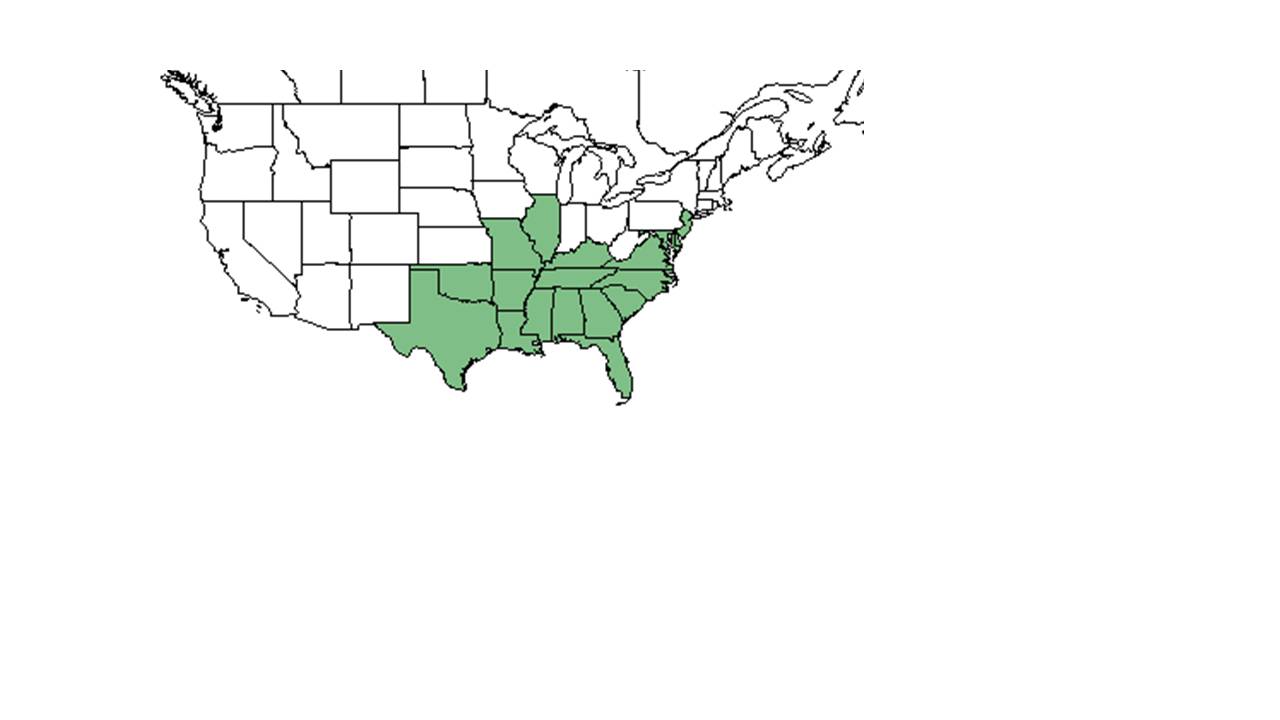Difference between revisions of "Centrosema virginianum"
(→Ecology) |
(→Diseases and parasites) |
||
| Line 57: | Line 57: | ||
===Diseases and parasites=== | ===Diseases and parasites=== | ||
| − | + | ''C. virginianum'' can be infected by the root-knot nematode species ''Meloidogyne arenaria'' and ''M. javanica'', but it is moderately resistant.<ref name= "Quesenberry">Quesenberry, K. H., et al. (2008). "Response of native southeastern U.S. legumes to root-knot nematodes." Crop Science 48: 2274-2278.</ref> | |
==Conservation and management== | ==Conservation and management== | ||
Revision as of 15:24, 4 April 2019
| Centrosema virginianum | |
|---|---|

| |
| Photo by Gil Nelson | |
| Scientific classification | |
| Kingdom: | Plantae |
| Division: | Magnoliophyta - Flowering plants |
| Class: | Magnoliopsida – Dicotyledons |
| Order: | Fabales |
| Family: | Fabaceae ⁄ Leguminosae |
| Genus: | Centrosema |
| Species: | C. virginianum |
| Binomial name | |
| Centrosema virginianum (L.) Benth. | |

| |
| Natural range of Centrosema virginianum from USDA NRCS Plants Database. | |
Common name: Spurred butterfly pea
Contents
Taxonomic notes
Synonyms: Centrosema virginianum (Linnaeus) Bentham var. virginianum; C. virginianum (Linnaeus) Bentham var. ellipticum Fernald; Bradburya virginiana (Linnaeus) Kuntze; C. virginianum (Linnaeus) Bentham var. angustifolium (A.P. de Candolle) Grisebach
Varieties: none
Description
Centrosema virginianum is a perennial herbaceous vine. It grows as a twining vine, climbing on other vegetation.[1] The leaflet langth to width ratio is very variable.[2]
Centrosema virginianum is seen growing in a tailing, climbing, and twining fashion. The plant is a perennial herbaceous vine that grows 0.5-1.5 m long, and is more or less minutely pubescent throughout. The leaves are 3-foliolate; the leaflets are widely to narrowly ovate, ovate-lanceolate or oblong to elliptic, are conspicously reticulate, mostly growing 2-7 cm long, and are stipellate. The stipules are ovate-lanceolate to lanceolate, striate, persistent, 1.5-4 mm long. The racemes are with peduncles usually growing 1-5 cm long, the zig-zag rachis bears 1-4 nodes each with an ovate bract growing up to 1.5-3 cm long subtending a pedicel (growing 2-10 cm long) surmounted by 2 ovate bractlets growing 0.8-1.2 cm long. The calyx is somewhat hidden by the braclets, the tube is broadly hemispheric, growing 4-5 mm long, the lobes are linear-subulate, growing 0.6-1.4 cm long, the lowermost longest. The petals are pale blue-violet to lavender in color, growing 2.5-3.5 cm long, is spurred near the base, the wigs and keel are nearly equal in size, ca. 2 cm long. The stamens are diadelphous, 9 and 1. The legume is linear, flattened, and grows 7-14 cm long and ca. 4 mm broad, is subsessile, many seeded with an elongate, persistent, beak-like style, valves longitudinally twisting after dehiscence.[3]
Distribution
C. virginianum is native to the southeast United States, north up to Illinois and New Jersey, along the east coast and south to Florida, and west to Texas and Oklahoma. It is also native to Puerto Rico as well as the Virgin Islands.[4]
Ecology
It is a legume that has one of the highest nitrogen-fixing potentials.[5] Because of this, it may be able to help restore N lost from fire.[6] By mid-season in June and July, a maximum nitrogen-fixing rate was observed.[5]
Habitat
It is found in a wide range of natural and disturbed conditions, including frequently burned sandhills, upland longleaf-wiregrass and old-field pinelands[6][7] and flatwoods, coastal island dunes and shorelines, open areas within mangrove swamps, wooded floodplains and edges of hardwood forests, and bogs . It can be found in loblolly pine communities.[7] It can also be found in longleaf pine-wiregrass communities.[6] As well, C. virginianum is a characteristic species of the shortleaf pine-oak-hickory community.[8] It is tolerant of overstory canopies that decrease the light level to about half the ambient (i.e., it can live in partially shaded areas and its nitrogen-fixing capability won't be significantly affected).[5] It grows in highly disturbed areas, but it is also ubiquitous in high quality native longleaf pine uplands and sandhills. It occurs in soils ranging from deep sands (Entisols) to sandy loams (Ultisols).
Associated species includes Blackberry Bramble, turkey oak, longleaf pine, Galactia, Strophostyles, Smilax, Penstemon, Lechea, Chrysopsis, Brumelia, Centrosema, Euphorbia, Cassia, Serenoa repens, Quercus incana, Quercus chapmanii, Diospyros, Aristida, Andropogon, bahia grass, Rubus, cloverleaf, Pinus taeda, Liquidambar styraciflua, and others.[1]
Phenology
C. virginianum has been observed flowering between April and October, with peak inflorescence in June and July, and fruits primarily in June thorugh September.[1][9]
Seed dispersal
This species is thought to be dispersed by ants and/or explosive dehiscence. [10]
Seed bank and germination
It spreads clonally by production of rhizomes.[11] Seed coats are hard and viable and seed can persist in the seed bank for at least two years. [12]
Fire ecology
It thrives under fire.[7] Hendricks observed that the Piedmont National Wildlife Refuge plots, which had been under a 4-year burning regime since 1966, each contained more than 10 times more C. virginianum individuals per ha than the Oconee National Forest plots, which had no burning history.[13] Seasonal burning does not seem to negatively affect nitrogen fixation.[14] C. virginianum showed increased flowering synchrony in response to lightning-season burns.[14] It responded the best to March burns with respect to annual tissue inputs as well as nitrogen contribution.[14] C. virginianum showed robust flowering response to late winter/ early spring burns, supporting the response to March burns noted earlier. It has a mid-summer flowering peak.[14] Also, one study found no evidence that increased flowering affects nitrogen-fixing capability.[14]
Pollination
Its flower is highly specialized for pollination by large Hymenoptera.[15] It requires bees for pollination to "trip" the pollen delivery mechanism. Pollinator-plant relationships appear to be robust to alteration in flowering phenology resulting from variation in season of burn.[14]
Use by animals
Because C. virginianum is a legume, and legumes are high in protein and mineral content, a number of herbivores including but not limited to Gopherus polyphemus, white-tailed deer, and bob-white quail, consume it.[6] It averages to be about 10-25% of the diet for large mammals and terrestrial birds.[16]
Diseases and parasites
C. virginianum can be infected by the root-knot nematode species Meloidogyne arenaria and M. javanica, but it is moderately resistant.[17]
Conservation and management
It is listed as endangered by the New Jersey Department of Environmental Protection and Energy.[4] C. virginianum is tolerant to the herbicide imazapyr.[18] Also for management, it benefits from the overstory canopy being thinned.[19]
Cultivation and restoration
Photo Gallery
References and notes
- ↑ 1.0 1.1 1.2 Florida State University Robert K. Godfrey Herbarium database. URL: http://herbarium.bio.fsu.edu. Last accessed: June 2014. Collectors: Loran C. Anderson, John C. Ogden, Gwynn W. Ramsey, R.K. Godfrey, R. S. Mitchell; R. C. Phillips, K. Craddock Burks, Gary R. Knight, D. W. Mather, C. Jackson, D. B. Ward, Mary Margaret Williams, O. Lakela, Brenda Herring, Jame Amoroso, Gwynn W. Ramsey, Richard Mitchell, Gail A. Steverson, Grady W. Reinert, George R. Cooley, R. J. Eaton, R. Kral, Cecil R Slaughter, Andre F. Clewell, R. Komarek, R. F. Doren, Kevin Oakes, Richard Gaskalla, Lisa Keppner, Clarke Hudson, Wilbur H Duncan, Jean Wooten, H. R. Totten, R. L. Wilbur, C. Ritchie Bell, Delzie Demaree, F. S. Earle, A. B. Seymour, Samuel B. Jones, Jr., H. R. Reed, A. B. Seymour, Michael B. Brooks, Sidney McDaniel, D. C. Bain, D. S. Correll, H. B. Correll, Lloyd H. Shinners, Geo M. Merrill, and H J Hamby. States and Counties: Alabama: Baldwin. Arkansas: Little Rock. Florida: Bay, Citrus, Collier, Duval, Escambia, Franklin, Gadsden, Gulf, Hillsborough, Jackson, Jefferson, Leon, Liberty, Manatee, Marion, Okaloosa, Polk, St Johns, St. Lucie, Suwannee, Wakulla, and Washington. Georgia: Bartow, Grady, Madison, and Thomas. Mississippi: Forrest, Harrison, Jackson, Pearl River, and Pike. North Carolina: Alamance, Orange, and Wilkes. Texas: Angelina, Bastrop, Freestone, Harris, Morris, Tarrant, and Van Zandt.
- ↑ Weakley, A. S. (2015). Flora of the Southern and Mid-Atlantic States. Chapel Hill, NC, University of North Carolina Herbarium.
- ↑ Radford, Albert E., Harry E. Ahles, and C. Ritchie Bell. Manual of the Vascular Flora of the Carolinas. 1964, 1968. The University of North Carolina Press. 635-6. Print
- ↑ 4.0 4.1 USDA, NRCS. (2016). The PLANTS Database (http://plants.usda.gov, 4 April 2019). National Plant Data Team, Greensboro, NC 27401-4901 USA.
- ↑ 5.0 5.1 5.2 Cathey, S. E., L. R. Boring, et al. (2010). "Assessment of N2 fixation capability of native legumes from the longleaf pine-wiregrass ecosystem." Environmental and Experimental Botany 67: 444-450.
- ↑ 6.0 6.1 6.2 6.3 Hainds, M. J., R. J. Mitchell, et al. (1999). "Distribution of native legumes (Leguminoseae) in frequently burned longleaf pine (Pinaceae)-wiregrass (Poaceae) ecosystems." American Journal of Botany 86: 1606-1614.
- ↑ 7.0 7.1 7.2 Cushwa, C. T. (1966). The response of herbaceous vegetation to prescribed burning. Asheville, USDA Forest Service.
- ↑ Clewell, A. F. (2013). "Prior prevalence of shortleaf pine-oak-hickory woodlands in the Tallahassee red hills." Castanea 78(4): 266-276.
- ↑ Nelson, G. PanFlora: Plant data for the eastern United States with emphasis on the Southeastern Coastal Plains, Florida, and the Florida Panhandle. www.gilnelson.com/PanFlora/ Accessed: 7 DEC 2016
- ↑ Kirkman, L. Katherine. Unpublished database of seed dispersal mode of plants found in Coastal Plain longleaf pine-grasslands of the Jones Ecological Research Center, Georgia.
- ↑ Hiers, J. K. and R. J. Mitchell (2007). "The influence of burning and light availability on N-2-fixation of native legumes in longleaf pine woodlands." Journal of the Torrey Botanical Society 134: 398-409.
- ↑ Coffey, K. L. and L. K. Kirkman (2006). "Seed germination strategies of species with restoration potential in a fire-maintained pine savanna." Natural Areas Journal 26: 289-299.
- ↑ Hendricks, J. J. and L. R. Boring (1999). "N2-fixation by native herbaceous legumes in burned pine ecosystems of the southeastern United States." Forest Ecology and Management 113: 167-177.
- ↑ 14.0 14.1 14.2 14.3 14.4 14.5 Hiers, J. K., R. J. Mitchell, et al. (2003). "Legumes native to longleaf pine savannas exhibit capacity for high N2-fixation rates and negligible impacts due to timing of fire." New Phytologist 157: 327-338
- ↑ Spears, Jr. E. E. 1987. Island and mainland pollination ecology of Centrosema virginianum and Opuntia stricta. J. Ecol. 75: 351-362.
- ↑ Miller, J.H., and K.V. Miller. 1999. Forest plants of the southeast and their wildlife uses. Southern Weed Science Society.
- ↑ Quesenberry, K. H., et al. (2008). "Response of native southeastern U.S. legumes to root-knot nematodes." Crop Science 48: 2274-2278.
- ↑ (2000). The role of fire in nongame wildlife management and community restoration: Traditional uses and new directions, Nashville, TN, USDA Forest Service, Northeastern Research Station.
- ↑ Brockway, D. G. and C. E. Lewis (2003). "Influence of deer, cattle grazing and timber harvest on plant species diversity in a longleaf pine bluestem ecosystem." Forest Ecology and Management 175: 49-69.